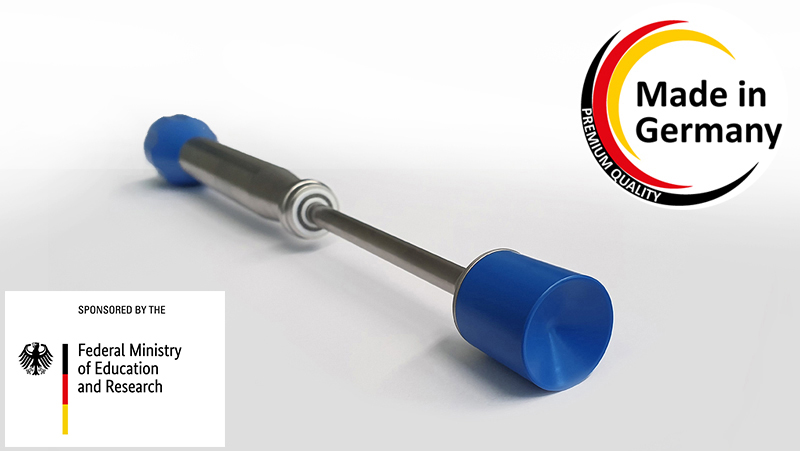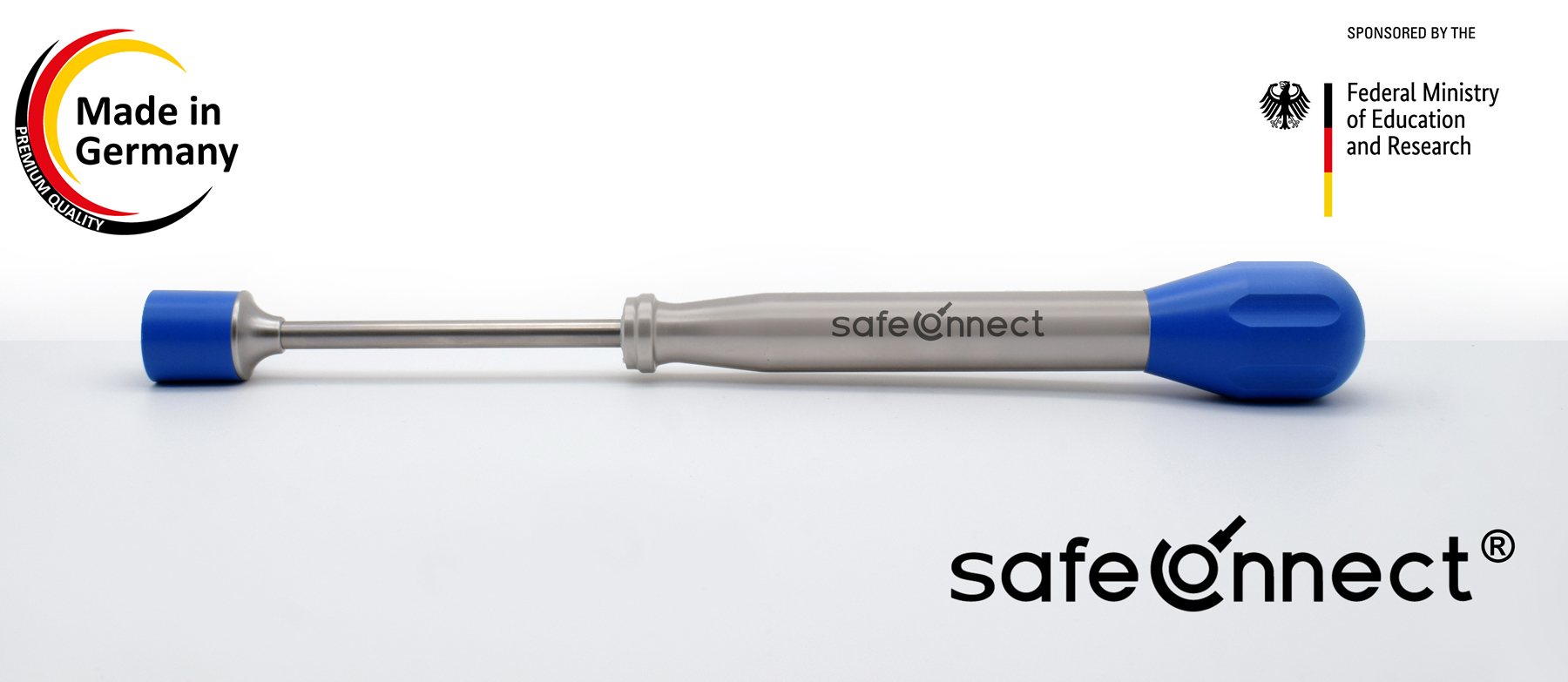safeConnect® dispositivo di unione per giunzioni coniche

Le differenze della forza d'urto risultanti dall'applicazione manuale di testina sferica o inlay applicate con il classico colpo di martello durante l'intervento chirurgico, rappresentano un potenziale rischio per la stabilità successiva della protesi stessa. Studi scientifici dimostrano che una forza di impatto precisa, applicata durante l'impianto, influenza la sicurezza della connessione conica con la protesi.
Grazie alla collaborazione con il laboratorio di Biomeccanica dell'università di Heidelberg è stato sviluppato lo strumento safeConnect che garantisce una procedura di unione fra testina e stelo o fra inlay e coppa con una forza calibrata precisa e costante.
Il processo di applicazione con forza costante è nuovo nel campo della chirurgia artroplastica, sia primaria che di revisione, e per questo brevettato mondialmente.

safeConnect è lo strumento essenziale per l'artroplastica primaria e di revisione.
Principio di funzionamento:
Lo strumento viene posizionato sulla testa a sfera o sull' intarsio della coppa e viene spinto manualmente nella direzione assiale della protesi. Un meccanismo all'interno dello strumento si attiva automaticamente e rilascia un impulso che unisce le componenti. Di conseguenza, la connessione conica viene creata da una forza precisa e standadizzata.
Vantaggi:
- Procedimento standardizzato e sicuro
- La trasmissione della forza é precisa e riproducibile
- Uno strumento per tutte le teste a sfera ed i cotili
- Semplice gestione chirurgica, facile da usare
- Strumento riutilizzabile
safeConnect - l'innovazione geniale per l'artroplastica dell'anca!

Come funziona safeConnect - Video
Per i sottotitoli in italiano, per favore attivare la funzione "sottotitoli" del video nel menu in basso.
È possibile poi scegliere la lingua dal menu "impostazioni".
| Articoli singoli e di ricambio | |||||
| Pos. | Art. nr. | Descrizione | Pos. | Art. nr. | Descrizione |
| 1 | 740100 | Strumento safeConnect | 4 | 740121 | Attacco per inlay Ø 28 mm safeConnect |
| 2 | 740120 | Attacco per testina sferica safeConnect | 5 | 740122 | Attacco per inlay Ø 32 mm safeConnect |
| 3 | 740124 | Attacco per inlay Ø 24 mm safeConnect | 6 | 740123 | Attacco per inlay Ø 36 mm safeConnect |
Letteratura sul tema
[1] LEARMONTH, I.D., YOUNG, C., RORABECK, C. (2007).
The operation of the century: total hip replacement. Lancet. 370 (9597): S. 1508-19.
[2] KAUFMANN-KOLLE, P., WILLMS, G. (Göttingen 2011).
Qualitätsreport 2010. Gemeinsamer Bundesausschuss Berlin. AQUA – Institut für angewandte Qualitätsförderung und Forschung im Gesundheitswesen GmbH.
[3] KURTZ, S., ONG, K., LAU, E., MOWAT, F., HALPERN, M. (2007).
Projections of primary and revision hip and knee arthroplasty in the United States from 2005 to 2030. J Bone Joint Surg Am. 89 (4): S. 780-5.
[4] BISHOP, N., WITT, F., POURZAL, R., FISCHER, A., RUTSCHI, M., MICHEL, M., MORLOCK, M. (2013).
Wear patterns of taper connections in retrieved large diameter metal-on-metal bearings. J Orthop Res. 31 (7): S. 1116-22.
[5] LANGTON, D.J., SIDAGINAMALE, R., LORD, J.K., NARGOL, A.V.F., JOYCE, T.J. (2012).
Taper junction failure in large-diameter metal-on-metal bearings. Bone and Joint Research. 1 (4): S. 56-63.
[6] KOCAGOZ, S.B., UNDERWOOD, R.J., SIVAN, S., GILBERT, J.L., MACDONALD, D.W., DAY, J.S., KURTZ, S.M. (2013).
Does Taper Angle Clearance Influence Fretting and Corrosion Damage at the Head-Stem Interface? A Matched
Cohort Retrieval Study. Seminars in arthroplasty. 24 (4): S. 246-254.
[7] LAKSTEIN, D., KOSASHVILI, Y., BACKSTEIN, D., SAFIR, O., LEE, P., GROSS, A.E. (2010).
Revision total hip arthroplasty with a modular tapered stem. Hip Int. 20 (2): S. 136-42.
[8] MCMASTER, W.C., PATEL, J. (2013).
Adverse local tissue response lesion of the knee associated with Morse taper corrosion. J Arthroplasty. 28 (2): S. 375.e5-8.
[9] MEYER, H., MUELLER, T., GOLDAU, G., CHAMAON, K., RUETSCHI, M., LOHMANN, C.H. (2012).
Corrosion at the cone/taper interface leads to failure of large-diameter metal-on-metal total hip arthroplasties. Clin Orthop Relat Res. 470 (11): S. 3101-8.
[10] LAVERNIA, C.J., BAERGA, L., BARRACK, R.L., TOZAKOGLOU, E., COOK, S.D., LATA, L., ROSSI, M.D. (2009).
The effects of blood and fat on Morse taper disassembly forces. Am J Orthop (Belle Mead NJ). 38 (4): S. 187-90.
[11] REHMER, A., BISHOP, N.E., MORLOCK, M.M. (2012).
Influence of assembly procedure and material combination on the strength of the taper connection at the head-neck junction of modular hip endoprostheses. Clinical biomechanics (Bristol, Avon). 27 (1): S. 77-83.
[12] NASSUTT, R., MOLLENHAUER, I., KLINGBEIL, K., HENNING, O., GRUNDEI, H. (2006).
[Relevance of the insertion force for the taper lock reliability of a hip stem and a ceramic femoral head]. Biomed Tech (Berl). 51 (2): S. 103-9.
[13] COOK, S.D., MANLEY, M.T., KESTER, M.A., DONG, N.G. (1993).
Torsional resistance and wear of a modular sleeve-stem hip system. Clinical materials. 12 (3): S. 153-8.
[14] MUNIR, S., WALTER, W.L., WALSH, W.R. (2015).
Variations in the trunnion surface topography between different commercially available hip replacement stems. J Orthop Res. 33 (1): S. 98-105.
[15] GILBERT, J.L., BUCKLEY, C.A., JACOBS, J.J. (1993).
In vivo corrosion of modular hip prosthesis components in mixed and similar metal combinations. The effect of crevice, stress, motion, and alloy coupling. J Biomed Mater Res. 27 (12): S. 1533-44.
[16] KRETZER, J.P., JAKUBOWITZ, E., KRACHLER, M., THOMSEN, M., HEISEL, C. (2009).
Metal release and corrosion effects of modular neck total hip arthroplasty. Int Orthop. 33 (6): S. 1531-6.
[17] GOLDBERG, J.R., GILBERT, J.L. (2003).
In vitro corrosion testing of modular hip tapers. J Biomed Mater Res B Appl Biomater. 64 (2): S. 78-93.
[18] KHAN, M.A., WILLIAMS, R.L., WILLIAMS, D.F. (1999).
The corrosion behaviour of Ti-6Al-4V, Ti-6Al-7Nb and Ti-13Nb-13Zr in protein solutions. Biomaterials. 20 (7): S. 631-7.
[19] GRUPP, T.M., WEIK, T., BLOEMER, W., KNAEBEL, H.P. (2010).
Modular titanium alloy neck adapter failures in hip replacement--failure mode analysis and influence of implant material. BMC Musculoskelet Disord. 11: S. 3.
[20] GOLDBERG, J.R., GILBERT, J.L., JACOBS, J.J., BAUER, T.W., PAPROSKY, W., LEURGANS, S. (2002).
A multicenter retrieval study of the taper interfaces of modular hip prostheses. Clin Orthop Relat Res. 401: S. 149-61.




